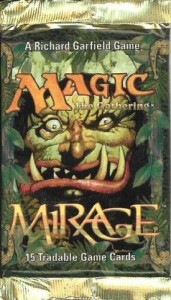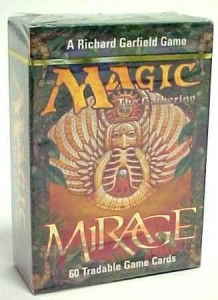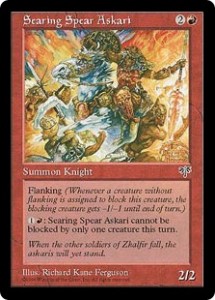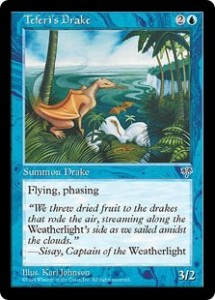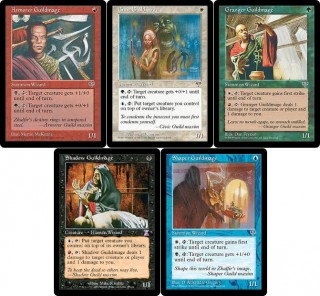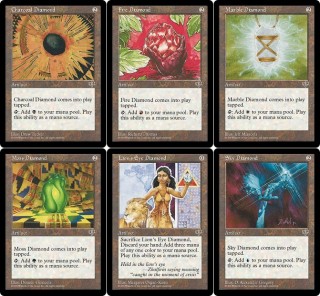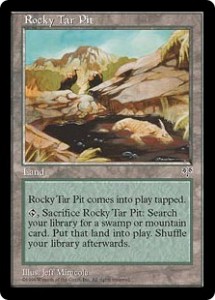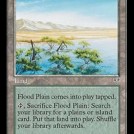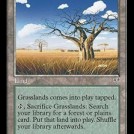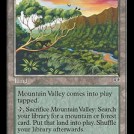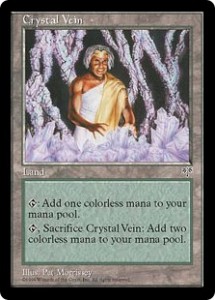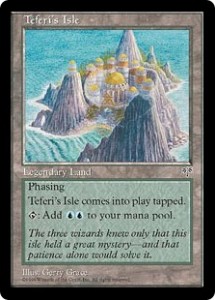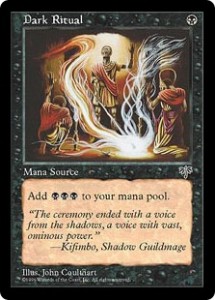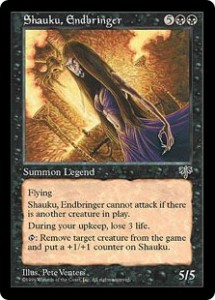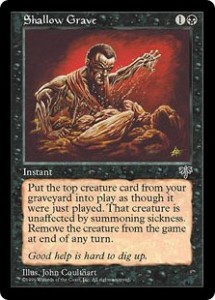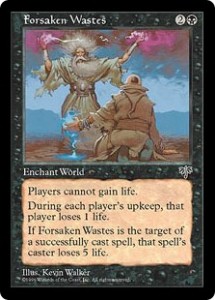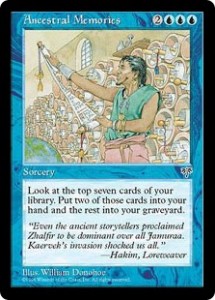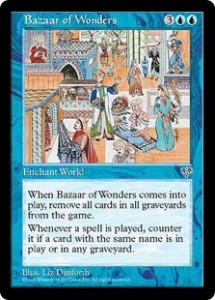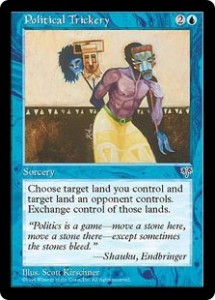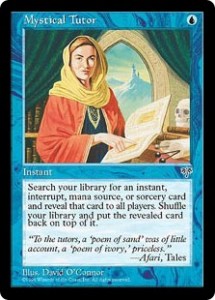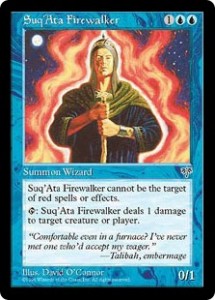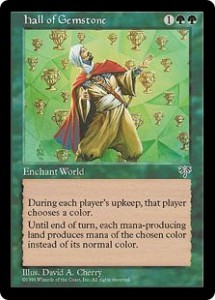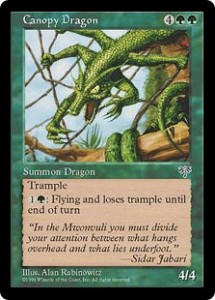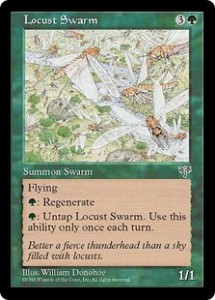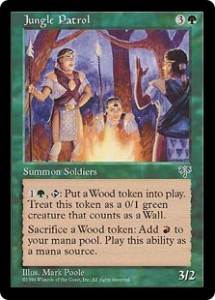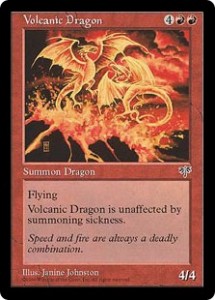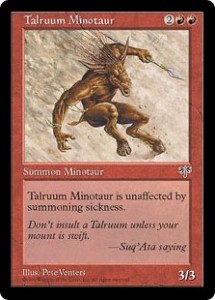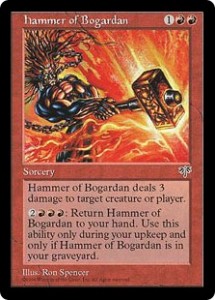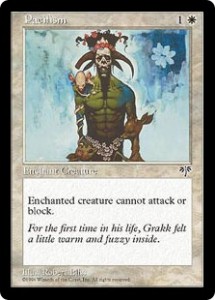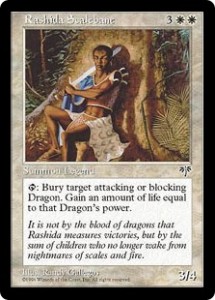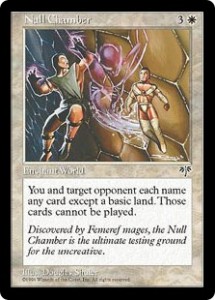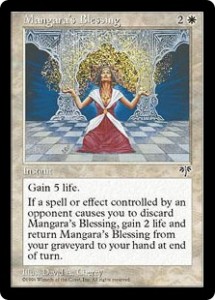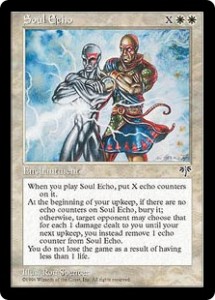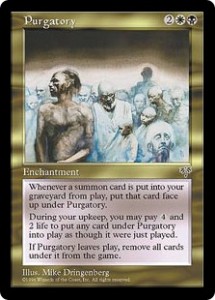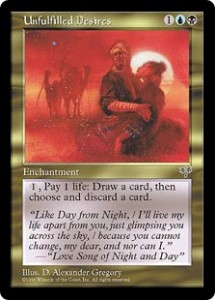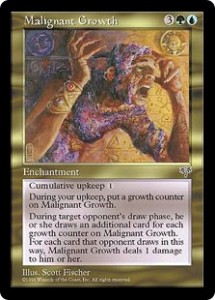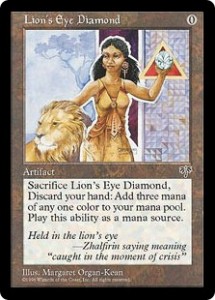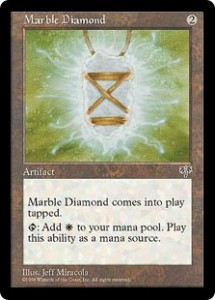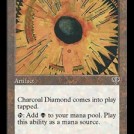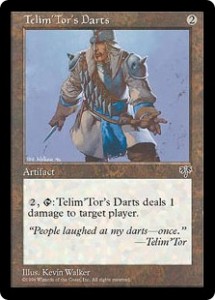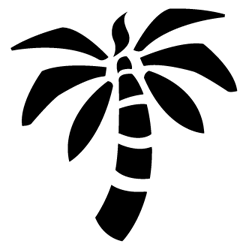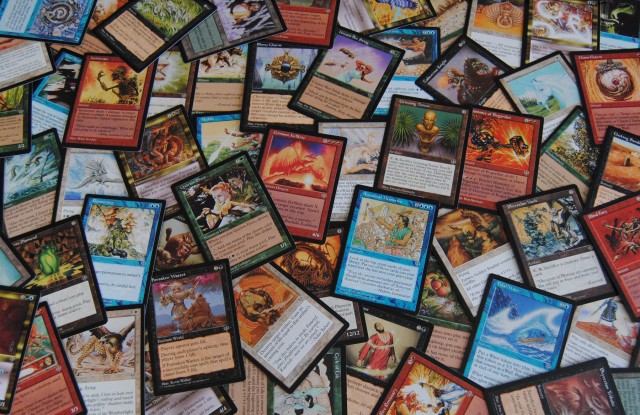
An Introduction to Mirage
On October 8th, 1996, Mirage was released, as a stand alone set similar to Ice Age, for Magic: The Gathering. It had the feel of Ice Age, but was much more balanced and introduced many new card types, such as Charms and Tutors, as well as, adding new tribes and bolstering existing ones. Mirage also created additions to the rule book by adding two new rules; Flanking and Phasing.
The set totaled 350 cards, including Basic Land, as this was a stand alone expansion set. The color breakdown was as balanced as any other set, 27 Lands, 51 Black cards, 51 Blue cards, 51 Green cards, 51 Red cards, 51 White cards, 35 Gold or Multicolor cards and 33 Artifacts. Just like Ice Age, it was balanced on rarity as well, 110 Commons, 110 Uncommons, 110 Rares and 20 Basic Lands having four variations on each Basic Land type.
According to The Duelist magazine #13 from October of 1996, when the Mirage was released, “Mirage made changes to the traditional magic environment: cards that provide options, top-of-the-library effects, variations of known themes, flanking, phasing, and a stronger emphasis on creatures.”
The changes Mirage made for the long haul, by changing they way Magic was played and the way sets were developed, was far reaching. Each color wasn’t as unique as with sets before. Each color had it’s own Charm, Dragon, and Guildmage, as well as it’s own corresponding Diamond Artifact. Each color was also given a choice Enchant Creature that could be used as an Enchant Creature or an Instant.
The balance in Mirage was also across fewer colors as well, not just all five. Three colors had a Djinn, three had a Tutor and four had a Knight or Knight-like creature, as I’m counting Jolreal’s Centaur for Green as a Knight.
Mirage also reintroduced the Legendary Land with Teferi’s Isle, which was a sign of things to come, for future sets. There were 12 Legendary creatures and new tribes such as Golems and Griffins. Goblins, Dwarves, Djinns, Knights, Merfolk, Elves and other existing tribes were all bolstered by Mirage, as well.
This was a stand alone expansion, similar to Ice Age, and as such had 14 reprints from previous sets and eight functional reprints. All told, Mirage was quite the game changer and like Ice Age, could be played self-sufficiently without cards from additional sets.
The New Rules of Mirage: Flanking and Phasing
Flanking and Phasing were Magic: The Gatherings first new rules since it’s inception. Ice Age had introduced “Cumulative Upkeep,” but that was a tweak on upkeep costs which had existed in Magic all along.
Flanking is by far the easier of the two to understand. The official rule book for Mirage stated that, “Flanking is an ability that gives an advantage to attacking creatures. Whenever a creature without Flanking is assigned to block a creature with Flanking, the blocking creature gets -1/-1 until end of turn.” Flanking was an interesting, new and fun concept when Mirage was released and has since been used in various sets and there are currently 29 creatures with the ability, 10 of which are in Mirage.
Obviously, based on the number of cards that have been printed since, Flanking wasn’t the ability Wizards of the Coast was hoping it would be, or perhaps they didn’t want it to be any more than a passing fancy. Interestingly, Blue was the only color not to have a Flanking creature in Mirage.
Phasing was also, not a long lasting ability as there are only 17 cards with Phasing and, again, 10 of them were printed in Mirage. Phasing causes permanents to enter and leave play on their own. A permanent with Phasing, phases in and phases out.
“When a permanent phases out, it leaves play and is set aside much as if it had been removed from the game.” Any enchantments or permanent alterations phase out with it. “All damage on it is removed, and because it’s considered out of play, any effects scheduled to affect it at end of turn are ignored.”
“A permanent that’s phased out will phase in at the beginning of its controller’s next untap phase.” It phases in as it phase out, so if it was tapped it phases in tapped, but it does phase in without summoning sickness, now known as haste. “A permanent with Phasing phases out automatically at the beginning of it’s controller’s untap phase, at the same time as other permanents would be phasing in. It doesn’t phase out on the turn in which it phased in.”
I will admit that, unlike Flanking, Phasing took some getting used to, but it could be abused and was thus a very well thought out new rule, if anything, it was and has since been underutilized.
Dragons, Wizards, Charms, Diamonds and Choice Enchant Creatures: Balance between the Colors of Mirage
As I stated earlier, each color had it’s own Dragon; Canopy Dragon for Green, Catacomb Dragon for Black, Mist Dragon for Blue, Pearl Dragon for White, Crimson hellkite and Volcanic Dragon for Red and even Teeka’s Dragon an Artifact Creature. This kind of balance, giving each color it’s own creature in a tribe was unheard of until Mirage, and it didn’t stop with Dragons.
Although there were 11 Wizards in Mirage, there were five, one in each color that had two abilities, each costing a color Mana not of that creature’s color to activate and these were the Guildmages. Armorer Guildmage for Red, Civic Guildmage for White, Granger Guildmage for Green, Shadow Guildmage for Black and Shaper Guildmage for Blue.
This balance wasn’t stopped at creatures and creature types either, it was extended into Instant cards with the Charms; Chaos Charm for Red, Ebony Charm for Black, Ivory Charm for White, Sapphire Charm for Blue and Seedling Charm for Green. Each of these was dynamic and built upon the this-or-that type card that was first put forth in Alliances.
Each Charm had “Choose one -,” followed by three options. This has since been replicated in other sets, as there are now 40 Charms, each balanced across the five colors and some are even Gold Instants.
There was also another choice card in Mirage, beyond the Charms, and it took the form of an Enchant Creature that could be played as an Instant and was buried at the end of turn. Again, each color had their own; Armor of Thorns for Green, Grave Servitude for Black, Lightning Reflexes for Red, Soar for Blue, and Ward of Lights for White.
There was also a balance for the Diamond Artifacts. There were actually six Diamonds, one for each color and then the toned down Black Lotus of Lion’s Eye Diamond.
The colored Diamonds all cost two Mana, all came into play tapped and all could be tapped for one Mana of the corresponding color; Charcoal Diamond for Black, Fire Diamond for Red, Marble Diamond for White, Moss Diamond for Green and Sky Diamond for Blue.
The balance in Dragons, Wizards, Charms, choice Enchant Creatures and the Diamonds was not something that was expected from Mirage, but was brilliant at keeping competitive balance between the colors and has since been replicated in other expansion sets, and not just stand alone expansions, either.
The Lands of Mirage: Sac and Cast plus a Legendary Land
There were 12 Lands printed in Mirage, five Basic Lands, five dual sacrifice Lands (sac Lands), Crystal Vein and the Legendary Land of Teferi’s Isle. The five Basic Land are self explanatory, but the five dual sac Lands were interesting.
Each of the sac Lands came into play tapped and could be tapped and sacrificed to find either one of the two corresponding basic Lands from your library and put it into play untapped. Bad River was for Islands and Swamps, Flood Plain was for Plains and Islands, Grasslands was for Forests or Plains, Mountain Valley was for Mountains or Forests and Rocky Tar Pit was for Swamps or Mountains.
They weren’t the fastest Lands in Magic, but for a dual color deck, getting one early meant that based on your draw, you could choose which Land you needed to get and that was an advantage. No one likes holding a hand full of Black cards in a Black/Red deck, with only a Mountain in play and so Rocky Tar Pit took care of that. Granted these lands were most useful early in the game, but they weren’t the worst thing to see later on. Holding on to one, in the event of an Armageddon or Jokulhaups, meant that you could start over with the Land you needed, instead of the Land you were lucky enough to draw.
The sac Lands were useful, but Crystal Vein was even more useful. Crystal Vein could be tapped for one colorless Mana or could be tapped and sacrificed for two colorless Mana. This was useful for getting bigger creatures out faster or for gaining an additional Mana for that Fireball or Disintegrate that you’ve been holding on to, in order to finish off your opponent.
It was also a good sacrifice play to cast an early Diamond or for a more offensive play; Winter Orb or Millstone, and I’ve even seen two sacrificed for and early Icy Manipulator.
Between Ice Age, Alliances and Mirage, plus Fourth Edition, there were plenty of Artifacts that could be cast early or first turn with Crystal Vein. In fact, I once saw it sacrificed on the first turn to cast an Ivory Tower and a Black Vise. Now that is what I call a very offensive and defensive play on turn one. But the best of the Lands in Mirage was Teferi’s Isle.
Teferi’s Isle was a Legendary Land, with Phasing, that could be tapped to add two Blue Mana to your Mana pool. Now, because Teferi’s Isle had Phasing, if you timed it right, you could put two into play and always have one Phasing in, when the other was Phasing out, which was a huge advantage for Blue as it was one land that could cast either an Arcane Denial or Counterspell.
With that being said, if it phased out tapped, it phased in tapped, so having two was good, but having two with a Juniper Order Druid, Ley Druid or Twiddle, so that you could untap it before it phased out was a greater advantage.
Teferi’s Isle was also used in conjunction with Armageddon while it was phased out, which gave you quite the Mana advantage when it phased back in. Teferi’s Isle was the first Legendary Land printed since Legends and would be a sign of more to come, as there would be more printed in Stronghold, Urza’s Saga and Urza’s Destiny.
The Color Black in Mirage: Creatures, Destruction and Graveyard Manipulation
Mirage had a focus on creatures and Black was no exception to that focus, but it wasn’t all creatures either. Black in Mirage was just as much about graveyard manipulation as it was about the creatures that went into the graveyard.
As with Ice Age, Dark Ritual was reprinted in Mirage, as was Dark Banishing and Drain Life. Stupor was an additional Sorcery for discard decks, Choking Sands brought cheap Land destruction back to Black and there was even Withering Boon, “Counter target summon spell,” for one colorless and one Black Mana, plus three life.
Mirage gave Black a Dragon in Catacomb Dragon and another Rat in Sewer Rats to expand that tribe, but these were the tip of the iceberg. Crypt Cobra, on the heels of Alliances’ Swamp Mosquito gave Black another poison counter creature, and Skeletons, Zombies and Knights were added to the Black army as well. But it was two Legends that were the standouts.
First up is Shauku, Endbringer, who for five colorless and two Black Mana was a 5/5 flying Legend, with an upkeep cost of losing three life. Shauku “cannot attack if there is another creature in play,” but Shauku could use its ability to get rid of creatures and boost itself.
“TAP: Remove target creature from the game and put a +1/+1 counter on Shauku.” So you can remove the other creatures, yours included from the game, and by the time Shauku can attack, it should be well over 10/10. The downside, was the cost, lose three life, because it was like Juzaam Djinn, it didn’t matter if you wanted to pay it or not, it just hits you until you win or are dead.
Spirit of the Night was not just an ordinary Legend, either. Sure, it was a 6/5 Flying, Trample, Protection from Black, unaffected by Summoning Sickness creature that cost six colorless and three Black Mana, but that could be bypassed with Urborg Panther.
Urborg Panther said, “Sacrifice Feral Shadow, Breathstealer, and Urborg Panther: Search your library for Spirit of the Night and put it into play as though it were just played. Shuffle your library afterwards.” Not every Legend has an alternate way to get itself into play and Spirit of the Night did. But it wasn’t all about Legends.
Tainted Specter, had a great ability to have target player choose a card from his or her and and then decide whether or not to discard that card or put it on top of their library. If the card was discarded, Tainted Specter dealt one damage to each creature and player, which meant you could target yourself to have your own personal Pestilence within a 2/2 flying creature.
Gravebane Zombie, was Black’s version of a Blinking Spirit, because if it was put into the graveyard from play, it was put on top of owner’s library. Harbinger of Night was another way to deal with creatures as it said, “during your upkeep, put a -1/-1 counter on each creature.” The best part about harbinger of Night was that these were permanent counters and weren’t removed even if harbinger of Night left play.
Bone Harvest allowed you to put any number of creature cards from your graveyard on top of your library and had a cantrip attached to it. Infernal Contract cost three Black Mana and made you pay half your life, rounded up to draw four cards, but at a certain point in the game, half you life is a cheap cost.
Enfeeblement was better than a Weakness, because it was -2/-2, Soul Rend was a Terror for white creatures with a cantrip, Soulshriek gave target creature +*/+0, where * was equal to the number of creature cards in your graveyard, which was a great play before you used Bone Harvest.
Phyrexian Tribute gave you the ability to sacrifice two creatures to destroy target artifact, which made it easier to get creatures into your graveyard for the Soulshriek. Grave Servitude, Black’s choice Enchant Creature gave target target creature +3/-1 and was better used as an Instant rather than an Enchantment.
Putting creatures in your graveyard was great for Forbidden Crypt, which allowed you to draw cards from your graveyard instead of your library, but stipulated that if you cannot draw a card from your graveyard, you lose the game. So, a Tormod’s Crypt would be the end of you.
Tombstone Stairwell had a Cumulative upkeep, which was good because you wouldn’t want it around forever. While it was in play each player puts a 2/2 Black Zombie token, unaffected by summoning sickness into play during each player’s upkeep for each summon card in that player’s graveyard. So if you could have your own Tormod’s Crypt, it would be very beneficial to you and useless for your opponent.
Shallow Grave, made the top creature in your graveyard a Ball Lighning, by putting it into play without summoning sickness and removing it from the game at the end of that turn.
It was commonly paired with the Chronicles reprinted Elder Dragon Legends and other expensive casting cost creatures, but it was just one reason why there was so much need to control what was in your graveyard at any given time. The other scary thing about Shallow Grave was it’s cost, one Dark Ritual was all it would take, so one available Black Mana was to be feared.
For my money, the most interesting card in Black for Mirage was Forsaken Wastes.
“Players cannot gain life. During each player’s upkeep, that player loses 1 life. If Forsaken Wastes is the target of a successfully cast spell, that spell’s caster loses 5 life.” This was great in Black/White melee decks, where if you could protect yourself with COPs, you could just wait out the game for your opponents to die. That is until one of them decided to take the five life and destroy the Wastes.
The Color Blue in Mirage: More Card Draw, Counters, Control, Phasing and an improved Tim
In Mirage, Blue became every other color’s best friend. The creatures, spells and enchantments of Blue were all great in mono Blue decks, but were much better when paired with other colors.
First up is Ancestral Memories, which cost two colorless and three Blue Mana, but allowed you to “look at the top seven cards of your library. Put two of those cards into your hand and the rest into your graveyard.” While this was good for Blue, it was even better for Black, with all of its graveyard manipulation, Ancestral Memories was a great way to stockpile your graveyard for future manipulation.
Blue was given some standards as well, Boomerang was reprinted; Arcane Denial, Counterspell, Force of Will and the other counters were joined by Dissipate, which cost one colorless and two Blue Mana, but removed the countered spell from the game. Deflection from Ice Age was give a Deflection lite in Meddle, which just changed the target of a spell targeting a single creature.
Soar was Blue’s enchant creature or Instant card, giving target creature +0/+1 and flying, which was great for springing a blocker on an attacking flyer when you have no flyers in play.
Before Leyline of Singularity from Guildpact there was Bazaar of Wonders from Mirage. “When Bazaar of Wonders comes into play, remove all cards in all graveyards from the game. Whenever a spell is played, counter it if a card with the same name is in play or in any graveyard.”
This was wonderful for Blue in conjunction with Soldevi Digger, which would allow you to put those used cards from your graveyard onto the bottom of your library so you could use them again, leaving your opponent, with three useless cards from their play set, if they had already played a card from the set.
Daring Apprentice was a 1/1 Wizard that could be sacrificed to “Counter target spell.” This was commonly paired with Ice Age‘s Enduring Renewal, which gave you a never ending supply of Counterspells for your opponent to deal with. Dream Cache, gave you card draw advantage without losing cards to the graveyard, it said “Draw three cards. Choose two cards from your hand and put both on either the top or bottom of your library” and with Alliances library manipulation, any card put on the bottom of the library wouldn’t remain there for long.
There was trading to be done, too. Political Trickery gave to the ability to exchange ownership of a Land with target opponent and Psychic Transfer allowed you to exchange life totals with target player if the difference was five or less and you had at least one life. Polymorph was fun for a different type of exchange as it buried target creature and that creature’s controller revealed the top card of his or her library, until a creature is found, to be put in play in the buried creature’s place.
This was obviously a gamble, that could work against you at times, but with Blue, you could always steal the creature, if it was better. With all of Blue’s library manipulation, this was also a cheap way to sacrifice a creature you have in play, for an expensive one that you knew was on top of your library.
If you can produce Mana at an alarming rate, Energy Vortex is a great way to slow down your opponent’s spending habits or deal them massive amounts of damage. Hakim, Loreweaver is a Legend that allows you to bring creature Enchantments back from the graveyard and when paired Ice Age’s Crown of Ages, makes all of your creature Enchantments reusable.
Flash allowed you to put a creature card from your hand into play with its casting cost reduced by two colorless Mana, whenever you wanted and Tidal Wave was an Instant that gave you a 5/5 blocker until end of turn. These two cards, when used with Righteousness gave you a 12/12 Wave token that could be sacrificed with Flash to cast the dreaded Phyrexian Dreadnought. In fact, although you had to wait to be attacked, this was the most effective way to cast the Dreadnought.
Mind Bend was a Magical Hack and Sleight of Mind in one, meaning that you could change a color or basic Land type. This was better than the other two, because it gave you the abilities of each and put the choice into your hand, based on whatever you may require at the time of casting it. Along the same lines, Prismatic Lace, had the power of all the laces, giving you the ability to change the color of target permanent to the color or colors of your choice.
Of the ten cards with Phasing, eight of them were Blue, one was Teferi’s Isle and the other was the Gold Green and Blue Warping Wurm. Of those phasing cards, there are a few of note; Cloak of Invisibility gave target creature phasing and made that creature blockable only by walls, Teferi’s curse gave target artifact or creature phasing and Teferi’s Imp made you discard a card when it phased out and draw a card when it phased in.
Vaporous Djinn didn’t have phasing per se, but if you didn’t pay the upkeep cost, it would phase out, which was brilliant. Phasing that you can control, meant that you could hit your opponent with Vaporous Djinn, a few times and, then make sure it phases out when you want to Wrath of God. That puts the phase out on your terms and you don’t have to wait for it. This was a novel concept, but there was one creature with phasing that you were fine waiting for; Taniwha.
Taniwha, a 7/7 Phasing, Trample Legend had an additional ability; “At the beginning of your upkeep, all lands you control phase out.”
Now, obviously this wasn’t every turn, because Taniwha was only in play every other turn, but when timed correctly, with the Diamonds, Fellwar Stones and other Mana-producing Artifacts or creatures, you could clear the board with an Armageddon and have all of your lands come back the next turn. Or you could use a Jokulhaups and clear the board entirely, including the Taniwha, allowing you to rebuild with a full Mana pool.
It wasn’t all power spells and creatures, Blue received a tutor, as did Green and White, but Blue’s tutor was Mystical Tutor, which allowed you to search for an Instant of Sorcery card and put it on top of your library.
Given all of the amazing Sorceries and Instants in Blue’s arsenal this was a very powerful card, but as useful as it was, there was one card in Blue from Mirage’s print run that was even more coveted by players of Blue; Suq’Ata Firewalker.
Suq’Ata Firewalker, was just a 0/1 Tim (Prodigal Sorcerer), but had the additional ability of “Suq’Ata Firewalker cannot be the target of red spells or effects,” which meant, no longer did, a player of Blue have to worry about their Tim being blasted by a Lightning Bolt or Incinerate.
This was a huge shift and a great advantage to Blue and disadvantage to Red, although Red did still have ways to deal with this, those could be countered and Blue players didn’t have to worry about countering those targeted direct damage spells aimed at their Tim. (In my gaming store, at the time, Suq’Ata Firewalker was simply known as “Sucks for You.)
The Color Green in Mirage: Enchant, Enchantments and Going Useful and Large
Sure, Green has always been about creatures, but Mirage didn’t just give Green big and useful creatures, it also added powerful Enchantments and spells, too.
Tranquil Domain was an interesting take on the classic Tranquility, by leaving local enchantments unharmed, Nature’s Balance, was a Balance lite but just for Land, equalizing everyone at five land. But these were just some good spells, the permanent Enchantments of Green were wonderful.
Barbed Foliage removed flanking from creatures attacking you and did one damage to all non-flying attackers. Cycle of Life, temporarily took a creature summoned this turn and made it a 0/1, before returning it to normal and buffing it with a +1/+1 counter. Hall of Gemstone messed with any non-mono decks you were playing against, as it made each player choose a color each turn, leaving their Mana producing Lands to only produce Mana of the chosen color until end of turn.
Afiya Grove, came into play with three+1/+1 counters on it, that could be moved to a creature during your upkeep and if you could bounce it back to your hand, you could in theory, continually boost your creatures, so long as they weren’t buried or otherwise destroyed.
Preferred Selection was a better version of Sylvan Library, as it didn’t require you to pay life and those useless cards, were put on the bottom of your library, clearing the way for what you were looking for, much more effectively.
Of course Green also had ways to deal with Blue and Black; Decomposition gave target Black creature a cumulative upkeep of one life, Karoo Meerkat had protection from Blue and Roots of Life made you target Swamps or Islands when it came into play, gaining you one life whenever target opponent tapped the specified land.
The Green Dragon, was Canopy Dragon, a 4/4 Trample dragon that could be given flying and lose trample until end of turn. This was a versatility most Dragons needed an Enchantment to have, although having a flying trample dragon would be the best of both worlds. Crash of Rhinos was a, six colorless and two Green Mana costing, 8/4 with Trample, that if given an additional ability, say First Strike or Flying could be extremely hard for your opponent to handle.
Nettletooth Djinn was a 4/4, for three colorless and one Green Mana, that dealt you one damage during your upkeep. This was good news, because it didsn’t say “lose one life” which isn’t preventable, so it was much easier to deal with. Maro, on the other hand, had a power and toughness equal to the number of cards in your hand, so you had to play or not play your cards right. But Green wasn’t all about the big creatures.
Mtenda Lion was small, cheap and effective if your opponent had no access to Blue Mana, Femeref Archers could be tapped to deal four damage to target flying creature, which made it easy to handle Serra Angels and Sengir Vampires (if the Sengir wasn’t already buffed). Jolreal’s Centaur was a 2/2 with Flanking that could not be the target of spells or abilities, Uktabi Fairie was cheap 1/1 flyer that, as a last resort, was an expensive Shatter and Sabretooth Cobra dealt out poison counters, not just when it damaged a player, but the following turn as well, if a cost wasn’t paid to prevent the additional poison counter.
Locust Swarm was an expensive Will-‘O-the-Wisp that could be untapped once per turn, Mindbender Spores was very useful for a Wall, but most useful with Regeneration which was reprinted in Mirage, because it could render a creature tapped for four turns.
Wall of Roots could be used as a Wall, but could have a -0/-1 counter placed on it to gain one Green Mana. This could be done until you killed the Wall, which was a 0/5 when cast and unfortunately could only be used once a turn. Jungle Patrol was brilliant because you could create mini Tinder Walls; as 0/1 Wall tokens, that could be sacrificed for one Red Mana each.
Foratog, was similar to Atog of Antiquities, only you sacrificed a Forest to boost it and it was the beginning of the Atog Invasion as 13 Atogs now exist in Magic.
Quirion Elves replaced Llanowar Elves in two colored decks, as it produced Green Mana, and a Mana of the color chosen when cast, making it extremely versatile and a cheap option as a common, as far as actual money cost to the rare Birds of Paradise.
Armor of Thorns was probably the best of all the Enchant Creature or Instant spells, because it could be a mini Giant Growth at +2/+2 or a permanent mini Giant Growth. Armor of Thorns’ ability to be one or the other was key to it’s success and was the most widely used of all the Enchant or Instant choice spells.
Lure of Prey allowed you to cast big creatures for a mere two colorless and two Green mana as an Instant and Waiting in the Weeds gave you lots of little creatures, one for each untapped Forest controlled by each player. Late in the game that could give you an instant army.
Big creatures, small creatures, Enchantments, these are the norm for Green, but there were two abnormal cards for Green in Mirage; Unyaro Bee Sting and Worldly Tutor.
Unyaro Bee Sting was mind-blowing for it’s time, Green direct damage! Yes, it cost three colorless and one Green Mana, and yes it only did two damage, but it was Green direct damage.
This made it easier to deal those last two damage to an opponent. So, Green had entered onto the turf of Red and Black with a direct damage spell, but it also crept unto Black and Blue turf with it’s very own tutor; Worldly Tutor.
Worldly Tutor allowed you to “search your library for a creature card and reveal that card to all players,” then put that card on top of your library. This tutor was a huge advantage, in a color that was creature heavy.
But Worldly Tutor had other uses, in fact I once saw it used with a Millstone, to put out a Demonic hordes on turn three as part of an Animate Dead. For those who can’t follow, the player Worldly Tutored for a Demonic hordes, Millstoned himself to get it into his graveyard, so he could use his Animate Dead.
This kind of out-of-the-box thinking was widely used to utilize Worldly Tutor, as it was apparent from the creation of Mystical, Worldly and White’s Enlightened Tutor, that the days of Demonic Tutor were long gone. Otherwise, Wizards of the Coast would not have created three color and card type specific tutors.
The Color Red in Mirage: Direct Damage, Time Walk Ultimatum, Dragons and other Tribes
Mirage’s Red creatures were very tribal in their orientation; Dragons, Goblins, Dwarves, Knights, Efreets, Elementals, Minotaurs and yet there were still powerful spells to be added to Red’s arsenal of direct damage as well.
First off, although every color had it’s own Dragon in Mirage, Red was given two. Crimson Hellkite was originally called “Volcanic Fire Dragon,” but they changed the name when they decided to name Red’s other dragon, Volcanic Dragon.
Crimson Hellkite, was a hulking 6/6 flyer that, could deal X direct damage to target creature, but only if the X Mana was paid for in Red Mana. This did not seem to be a hindrance, neither was the six colorless and three Red Mana it cost to cast.
Crimson Hellkites always seemed to make an appearance in games, but this was in part due to Green’s Mana production with Birds of Paradise, Tinder Wall and Quirion Elves, not to mention Worldly Tutor.
That doesn’t mean Volcanic Dragon was a slouch. Volcanic Dragon cost the same as a Shivan Dragon but was a 4/4 that was unaffected by summoning sickness, and thus was added to the “First Turn Shivan” decks that Ice Age‘s Tinder Wall gave rise to, because if you could get it out on turn one, you could attack with it.
Meanwhile, due to the amount of Dragons added to the creature pool, Dragons were now a viable tribe and most tribes had leaders and tribal Dragons had two at the time, both of them Legends; hivis of the scale and Zirilan of the Claw.
Hivis of the Scale allowed you to gain control of target Dragon, whereas Zirilan of the Claw turned all Dragons in your deck into Ball Lightnings, allowing you to search your library for one to put into play, unaffected by summoning sickness and then remove it from the game at the end of the turn.
But Red wasn’t all about the Dragons.
The tribe of Goblins was bolstered by Goblin Elite Infantry, Goblin Scouts, Goblin Soothsayer and Goblin Tinkerer and the Dwarves added Dwarven Miner and Dwarven Nomad, to their ranks.
Knights were primarily for Black and White, but Red was given two in Mirage; Burning Shield Askari and Searing Spear Askari. Efreets were added to the ranks of tribes as well with Burning Palm Efreet and Wildfire Emissary. Elementals made a comeback with Flame Elemental and Subterranean Spirit.
Minotaurs only had one addition, but it was Talruum Minotaur and he was unaffected by summoning sickness and then there was Telim Tor, the only non-Dragon Legend in Red.
Telim Tor was a 2/2 with Flanking that, when he attacked, gave all other attacking creatures with Flanking +1/+1 and his Edict, Telim Tor’s Edict was a great way to not only remove target permanent you own from the game, but it had a cantrip with it and only cost one Red Mana.
Red is usually where you find the chaos from any given set and Mirage was no difference with Emberwilde Djinn and Illicit Auction.
Emberwilde Djinn was a flying 5/4 that could stolen as “during each player’s upkeep, he or she may pay two Red Mana or 2 life to gain control of Emberwilde Djinn.” This made the Djinn a risky play, but it was nothing when compared to the chaos of the win-win scenario of damaging your opponent or stealing their creature with Illicit Auction.
The Auction was simple, players bid life for control of target creature. Pick, a creature your opponent can’t live without and they’ll have to outbid you and take damage or give up the creature. Either way, you have the upper hand.
Red had it’s share of targeted color spells as well, Reign of Chaos destroyed a Plains and target White creature or an Island and target Blue creature, while Sirocco made your opponent reveal their hand and then made them discard every Blue Instant revealed, unless he or she payed four life per Blue Instant they wanted to keep.
Mirage in Red was very much about direct damage. First, there was Incinerate, reprinted from Ice Age, spelling the end of the road for Lightning Bolt. This was a very sad day for Red, but there was good news, too.
Spitting Earth had a cheap cost to kill a big creature, if you had enough Mountains in play and Torrent of Lava would either kill your opponent’s army or tap them and get them out of the way. If you only needed one attack, Torrent of Lava would clear the way, but there were three direct damage spells that stood above the rest; hammer of Bogarden, Kaevek’s Torch and Volcanic Geyser.
Hammer of Bogardan, was a one colorless and two Red Mana costing Sorcery that, dealt target creature or player three damage. But it could be brought back during your upkeep for two colorless and three Red Mana, if it was in your graveyard. With enough Mana at your disposal, you could hit your opponent every turn or at least every other turn.
The Hammer was nice, but it was still weak against Blue by comparison to Kaervek’s Torch the X casting cost, X damage dealing Sorcery that had an added bonus. “Interrupts that target Kaervek’s Torch each cost an addition two Mana to play.” This meant, if you opponent was holding a Counterspell or Arcane Denial and had saved two Mana to cast it, they wouldn’t have enough to counter the Torch and you could burn who or whatever you choose, without fear.
But for putting sheer terror into the heart of those playing against Red, Volcanic Geyser was cataclysmic. It was a two Red Mana and X costing, X direct damage spell that was an Instant. This meant, you could hit your opponent for X during their turn if you choose and not just during your turn as with the classic Sorceries of Disintegrate and Fireball. This was a huge advantage for Red, but it wasn’t the only advantage; enter Final Fortune.
Final Fortune, is a Time Walk with a catch. “Take another turn after this one. You lose the game at the end of that turn.” Which just means that you need to win the game during that extra turn. This was the first, completely obvious reprinting of a toned down version of a card from the “Power Nine,” and it wasn’t the only such incident in Mirage either. All told, Red decks that were powerful before Mirage, became that much more powerful because of the addition or implementation of cards from Mirage.
The Color White in Mirage: Griffins, Elephants, Enchantments, a New Dawn and an Army of Pegasus
White has always been about protection and weenies, but Mirage stood on the shoulders of Alliances and took it one further.
Benevolent Unicorn was a 1/2 for one colorless and one White Mana that had a great ability. “Whenever a spell assigns damage to a creature or player, that damage is reduced by 1.” So your protection was really multiplied by however many Benevolent Unicorns you could get into play. In fact, two was all you needed to really nullify a Lightning Bolt or Incinerate.
Spectral Guardian, as long as it was untapped, protected non-creature Artifacts from being targeted by spells or effects, so you could keep your combos intact, like your Winter Orb / Icy Manipulator and if you had a Unicorn in play, it would protect the Guardian.
Even more protection came to White in the form of Illumination, which was the closest White got to a Counterspell, by countering target Artifact or Enchantment spell and Vigilant Martyr was a creature that could counter a spell that targeted an Enchantment in play. If something did get through, you could use Disempower, to put target Artifact or Enchantment back on top of your library to cast and reuse it.
White always had both ends of the scales covered and in Mirage the scales were balanced by Favorable Destiny and Pacifism. Favorable Destiny made the target unable to be the target of spells or abilities if it wasn’t the only creature you controlled and if the enchanted creature was White it got an additional boost of +1/+2, whereas Pacifism rendered its enchanted creature relatively useless, making it unable to attack or block.
Mirage introduced a whole new tribe to White; Griffins. There were five in total; Ekundu Griffin, Mtenda Griffin, Teremko Griffin, Unyaro Griffin and Zuberi, Golden Feather, with Zuberi being a Legend that gave all other Griffins +1/+1. They could all fly and most had additional abilities, but this was their start, as there are now 37 Griffins in total.
There were also Knights with Zhalfirin Commander leading Zhalfirin Knight and Femeref Knight, as well as the tribe of Elephants, which like Griffins made their prime time debut in Mirage, there are now 40 Elephants.
White, like every other color in Mirage had its own Dragon; Pearl Dragon, which was the first of now six White Dragons that exist. Mirage also gave White another Angel in Melesse Spirit, which also gave rise to more Angels, now totaling 100.
Beyond Zuberi there were two other Legends in Mirage for White, Rashida Scalebane and Sidar Jabari. Rashida was the Dragon exterminator extraordinaire, being able to tap to “bury target attacking or blocking Dragon.”
On the other hand, Sidar Jabari, a mere 2/2 with Flanking that could tap target defending creature when he attacks, which seems tame, but his influence card was something else. Jabari’s Influence allowed you to take control of target non-Black creature that attacked you this turn, with a -1/-0 counter on it. It was the closest White had come to a Control Magic.
But White wasn’t all protection and offensive creatures.
Afterlife was White’s kinder and gentler version of Terror, giving the destroyed creature’s controller a 1/1 flyer. Wall of Resistance, was a flying Wall that could be pumped up to large proportions, as it started as a 0/3, but was given a +0/+1 counter at the end of any turn in which to was dealt damage and Auspicious Ancestor was a 2/3 creature with a built in Ivory Cup.
Null Chamber was a good card, allowing you to essentially, take a card out of your opponent’s arsenal, but was best if it could be bounced back to your hand and recast, so you could change the card named as the game wore on.
Classic White was always about the weenies i.e. Savannah Lions and Tundra Wolves, but Mtenda herder was just as useful as the others, because it was a 1/1 with Flanking, so it could easily deal with other first turn 1/1 creatures that opposed it.
Classic white was also about life gain, and if you can protect yourself from discard decks with a life gain card, then you have Mangara’s Blessing; a Guerrilla Tactics but better for life gain. When Alliances‘ Guerrilla Tactics is discarded it can deal four damage to the target of your choosing and that’s the end of it, but not so with Mangara’s Blessing.
When Mangara’s Blessing is discarded, because of an opponent’s spell, you gain two life and it returns to your hand from the graveyard at the end of the turn. I used to see this card in sideboards for decks with no White Mana sources, just to sideboard against discard decks.
White has always been harsh to Red and Black and Mirage had that handled as well with Mangara’s Equity and Shadowbane. Mangara’s Equity was an enchantment that dealt damage to creatures Red or Black (you chose one or the other when casting the Enchantment), for each damage dealt to White creatures you control or to you. Shadowbane prevented damage to you or a creature from any one source, but if the source was Black, you gained life for each damage prevented.
Ward of Lights, allowed you to choose a color when it was cast to give target creature protection from that color. This was White’s Enchantment or Instant card, although it was better for the long haul as an Enchantment than as a one turn Instant.
Soul Echo was a game changer, not in how it worked, but in the last line on the card, “You do not lose the game as a result of having less than 1 life.” This was a very different approach to the game.
Granted, Soul Echo wasn’t permanent, but it did hurt mono-Red decks the most, because without Green or White, mono-Red couldn’t remove enchantments from play. Still, even if you had a way to destroy the enchantment, Mirage had many ways to protect it’s enchantment’s and Soul Echo was definitely worth protecting.
Could White in Mirage get any Whiter, it had the protection, the weenies, the life gain and a few big creatures, but that wasn’t all White could do. White could make everything a whiteout and then punish you because of it.
First up was Blinding Dawn, a card that tapped all nonwhite creatures, but what if you were playing with more than just White, your own cards would be affected as well, wouldn’t they? That is correct, they would, that is if they weren’t White… Enter Celestial Dawn.
Celestial Dawn made everything White, it’s as simple as that. “All nonland cards you own that are not in play are White. All nonland permanents that you control are White. All lands you control are Plains. All colored mana symbols in all costs on all of these cards are [White Mana Symbol].”
Now that Blinding Light doesn’t affect any of your stuff and that Crusade pumps everything you put out. This was glorious, but there were still two cards more powerful than all of the cards I’ve mentioned in White so far; Sacred Mesa and Enlightened Tutor.
Sacred Mesa was a Pegasus army building machine for White, as it stood on the shoulders of Alliances’ Kjeldoran Outpost and literally reached into the skies, creating an army of 1/1 flyers.
During your upkeep you had to sacrifice a Pegasus or bury Sacred Mesa, but it only cost one colorless and one White Mana to create a Pegasus and the only limit you had on making as many per turn as you wanted was your Mana pool.
The other plus to Sacred Mesa, was that this ability wasn’t classified as a Sorcery, so it could be done during your turn, or any one else’s turn. In Blue/White decks, this meant that the one Plains and one Island you saved for your Arcane Denial, if unused at the end of your opponent’s turn, could be turned into a Pegasus token. This gave you an instant creature advantage, and with all of the enchantment protection that White in Mirage already had, Sacred Mesa was formidable.
So what could be better than creating an army of 1/1 flyers, that can be boosted to 2/2 with a Crusade? The card that can get you to the Sacred Mesa or Crusade faster; Enlightened Tutor.
Mystical Tutor was for Instants and Sorceries and Worldly Tutor was for Creatures, but Enlightened Tutor was for Artifacts or Enchantments, making it extremely powerful, in its time and today.
Think of all the great classic combos, Icy Manipulator and Winter Orb, Island Sanctuary and Mystic Decree, Enduring Renewal and the yet to be printed Goblin Bombardment from Tempest, and many others. Enlightened Tutor was a way to get to the part of the combo you didn’t have, or if you had the combo, it was a way to get the second or third copy of the component of the combo your opponent destroyed.
Enlightened Tutor’s reach was, well, far-reaching. It was even put into Green decks with no other White cards, because of the availability of White Mana from Birds of Paradise and Quirion Elves.
The Gold in Mirage: Rise of the Gold Enchantments
Multicolored or Gold cards have always been the home of powerful creatures and Legendary creatures, but in Mirage it was the spells and specifically the Enchantments that shown brightest.
Circle of Despair was an Black/White Enchantment similar to the Circle of Protections, only it was pay one colorless Mana and sacrifice a creature to “prevent all damage to any creature or player from any one source.” This when paired with Sacred Mesa or Breeding Pit could protect you for a long time. Purgatory, also a Black/White Enchantment, allowed you to recycle creatures that had died for a cost of four colorless Mana and two life.
Reparations was a Blue/White Enchantment that gave you the ability to draw a card if an opponent successfully cast a spell that targeted you or a creature you control. This gave Blue/White a card draw advantage, which it already had. Another Blue/White Enchantment Spatial Binding, gave you control over Phasing, by allowing you to pay 1 life to prevent target permanent from phasing out until the beginning of your next upkeep.
Unfulfilled Desires was a Blue/Black Enchantment that for one colorless Mana and one life gave you the ability to draw a card, then choose and discard a card. When paired with Soldevi Excavations, Soldevi Digger and all of the other library manipulation from Alliances, this card could really be abused for a massive card draw advantage.
Delirium was a great counter to one beefed up creature that your opponent was hoping to finish you off with. It’s a Black/Red Instant that can only be played during an opponent’s turn. Target creature becomes tapped and does an amount of damage equal to its power to its controller, which in the case of a Blood Lusted, Ball Lightning is 10 damage. Not bad, when you opponent was expecting to hit you with that 10/1. Kaervek’s Purge is a similar Sorcery for Black/Red, dealing X damage to target creature and if the creature is killed in this way, it deals its power in damage to its controller.
Phyrexian Purge was a Black/Red Sorcery that gave you carte blanche to destroy as creature as many times as you wanted to at a cost of three life per target. Savage Twister, on the other hand, was a Hurricane and Earthquake in one, without hitting players, so you could feel free to cast it for five damage, even if you were at four life.
Wellspring, a Green/White Enchant Land, allowed you to borrow enchanted Land during your turn, returning it back to it’s original owner after your turn, before returning back to you at the beginning of your turn again. It wasn’t that much of a detriment to your opponent as it was a benefit to you.
Asmira, Holy Avenger was the only Legend in Gold for Mirage. At the end of every turn, Asmira received a +1/+1 counter for each creature of yours that was put into the graveyard that turn. But the name of the game for Gold in Mirage was Enchantments and two were far and above the rest. One was the most used, Cadaverous Bloom, and the other was the most attempted, Malignant Growth.
Cadaverous Bloom gave Green and Black even more Mana advantage, than they had before with all of the Dark Rituals and Elves. Remove a card in your hand from the game and add two Green or two Black Mana to your Mana pool.
This card was not slowed down by its three colorless, one Black and one Green mana cost, because it could still be out turn two, with a first turn Forest and Elf and a second turn Swamp and Dark Ritual. The only downside was that the cards needed to be removed from the game to get Mana, but if a Cadaverous Bloom deck was working, that never came into play.
My personal favorite was Malignant Growth, a much maligned Blue/Green Enchantment that was interesting, to say the least, especially in melee games.
“Cumulative Upkeep: One Colorless Mana. During your upkeep, put a growth counter on Malignant Growth. During target opponent’s draw phase, he or she draws an additional card for each growth counter on Malignant Growth. For each card that opponent draws in this way, Malignant Growth deals one damage to him or her.”
This meant, that although you were giving your opponents’ a card draw advantage, that card draw advantage was slowly killing them, as well. If you could build your deck around, Mana to keep the Malignant Growth going and protection for yourself, you could easily win, but it was a slow deck and not so easily accomplished.
The Artifacts of Mirage: Old School Revisited and New School Themes
The balance of Mirage was exemplary in its Artifacts, a Diamond for each Color, an Artifact Dragon and plenty of other useful Artifacts, as well as, Lion’s Eye Diamond, a re-imagining of the Power Nine’s Black Lotus.
Lion’s Eye Diamond, was almost Mox Crystal which was later released, as Mox Diamond in Stronghold, but was printed in Mirage as Lion’s Eye Diamond, a toned down Black Lotus. Like the Lotus, it cost zero to cast and could be sacrificed for three Mana of any one color, but unlike the Lotus you needed to discard your entire hand as part of its activation cost. This didn’t stop its use though, as it was still versatile, although it it wasn’t truly as versatile as the Black Lotus itself.
The five colored Diamonds, were extremely useful. Each cost two colorless Mana and each came into play tapped, but even though they weren’t usable until turn two at the earliest, they were highly effective.
Marble and Moss Diamond, the White and Green Diamonds respectively, were both put into Ehrnageddon decks, to give you a source of Mana for rebuilding after the Armageddon. Although, overall the Diamonds were used by other colors to combat Armageddon decks.
The Diamonds replaced Fellwar Stone in most decks, because with Fellwar Stone, there was no guarantee that it would give you the color of Mana you required when tapped. The Diamonds were also a way to inject a second color into mono-color decks or a third color into two color decks without disrupting the Mana balance of the main color or colors of your deck.
The Diamonds were not a replacement for the Moxen of the Power Nine, but they were still effective and were widely used in the Type II decks of their time.
Artifact Mana production was additionally aided by Ventifact Bottle and Mana Prism, but the Artifacts of Mirage weren’t all about Mana production.
The Artifacts had their very own Dragon in Teeka’s Dragon, a nine colorless Mana costing, 5/5 flying, trample, rampage 4 creature that counted as a Dragon. Although nine colorless isn’t that hard to come by, with Zirilan of the Claw or any of the Green or Black spells to temporarily or permanently cast Teeka’s Dragon, it was easier to get out than the casting cost would suggest.
Artifacts also received its very own tribe, of sorts, with Golems; Basaslt Golem, Cyrstal Golem, Igneous Golem, Lead Golem, Patagia Golem and Sand Golem.
There was also the 12/12 behemoth of Phyrexian Dreadnought, which as I stated earlier (in the Blue section), was easier to get out than most expected.
Of course, when you have the opportunity to cast a 12/12 trample creature for one colorless Mana, it doesn’t matter what additional costs there are, players will find a way to get it into play.
Still, it wasn’t all about Artifact creatures. Phyrexian Vault allowed you to tap it, pay two colorless Mana and sacrifice a creature to draw a card, but with Breeding Pit from Fallen Empires, Kjeldoran Outpost from Alliances and Sacred Mesa from Mirage, creatures were much more expendable.
Razor Pendulum was a great way to finish off a player, “at the end of each player’s turn, if that player has 5 or less life, Razor Pendulum deals to damage to him or her.” Of course, you had to be careful with the Pendulum as it hit everyone, including you.
Discard decks were happy to add Paupers’ Cage into the fold, because it dealt damage to opponent’s, during their upkeep, if they had two or fewer cards in their hand.
Mangara’s Tome was brilliant for narrowing your deck down to the five cards you needed to win and then having easy access to them and Grinning Totem allowed you to search your opponent’s library for a card, that you could play as your own, or put into their graveyard if you couldn’t use it.
Life gain in Artifacts was assisted with Elixir of Vitality and Circle of Protections could be dealt with by using Ersatz Gnomes, which made target spell or target permanent colorless until end of turn. Amulet of Unmaking was an expensive way to remove an artifact, creature or land from the game, whether it be something that you own that is killing you, or something your opponent is going to kill you with.
Telim Tor’s Darts, was a two colorless costing, Artifact, that for two colorless Mana could be tapped to deal one damage to target creature or player. This was a great sideboard for Green, because you could Tim Blue’s Tims before they pinged off all of your elves.
In Conclusion Mirage
Mirage took the example of Ice Age as a stand alone expansion set and didn’t necessarily do it better, but it did it differently and that’s a good thing.
The inclusion of a Dragon for every color, as well as a Diamond Artifact and other such cards, balanced the competitiveness of each color.
Cards like Crimson hellkite, Quirion Elves, Phyrexian Dreadnought, Shauku Endbringer, Celestial Dawn, and all three Tutors; Mystical, Worldy and Enlightened, would all be used, not just during the time of Mirage, but throughout all of the coming expansions.
Mirage had a heavy dose of creatures, but the Gold Enchantments and the other powerful spells; hammer of Bogarden, Shallow Grave , Unyaro Bee Stting and many more would be part of Mirage’s legacy.
Let us also note, that Mirage was the first set to introduce the Charms, a spell that has since been a constant reminder, in many sets since, of what Mirage did, not only to change the way the game was played, but to change the way sets were developed.
